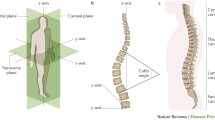Abstract
Adolescent idiopathic scoliosis (AIS) constitutes the common type of spinal deformity present between the 10- and 18-year-old age groups. Currently, the Lenke classification for AIS is the most widely used system to describe AIS pathology. The operative treatment of adolescent idiopathic scoliosis is still somewhat controversial regarding the selection of the appropriate regions to fuse and the selection of the specific upper instrumented vertebra (UIV) and lowest instrumented vertebra (LIV). Understanding the pattern of AIS deformities is important to choosing the appropriate surgical treatment. This chapter discusses the most popular classification for AIS, described by Lenke, and the selection of fusion levels.
Access this chapter
Tax calculation will be finalised at checkout
Purchases are for personal use only
Similar content being viewed by others
References
Newton PO, Samdani AF, Shufflebarger HL, Betz RR, Harms J. Idiopathic scoliosis; The Harms Study Group Treatment Guide. 2nd ed. Thieme; 2021.
Lenke LG, Betz RR, Harms J, Bridwell KH, Clements DH, Lowe TG, Blanke K. Adolescent idiopathic scoliosis: a new classification to determine extent of spinal arthrodesis. J Bone Joint Surg Am. 2001;83(8):1169–81.
Ponseti IV, Friedman B. Prognosis in idiopathic scoliosis. J Bone Joint Surg Am. 1950;32:381–95.
King HA, Moe JH, Bradford DS, Winter RB. The selection of fusion levels in thoracic idiopathic scoliosis. J Bone Joint Surg Am. 1983;65:1302–13.
Ishikawa M, Nishiyama M, Kamata M. Selective thoracic fusion for King-Moe type II/lenke 1C curve in adolescent idiopathic scoliosis: a comprehensive review of major concerns. Spine Surg Relat Res. 2019;3:113–25.
Lenke LG, Betz RR, Bridwell KH, Clements DH, Harms J, Lowe TG, Shufflebarger HL. Intraobserver and interobserver reliability of the classification of thoracic adolescent idiopathic scoliosis. J Bone Joint Surg Am. 1998;80(8):1097–106. https://doi.org/10.2106/00004623-199808000-00002.
Cummings RJ, Loveless EA, Campbell J, Samelson S, Mazur JM. Interobserver reliability and intraobserver reproducibility of the system of King et al. for the classification of adolescent idiopathic scoliosis. J Bone Joint Surg Am. 1998;80(8):1107–11. https://doi.org/10.2106/00004623-199808000-00003.
Lenke LG. SRS Terminology Committee and Working Group on spinal classification revised glossary of terms. Scoliosis Research Society; 2000.
Duong L, Cheriet F, Labelle H, Cheung KM, Abel MF, Newton PO, McCall RE, Lenke LG, Stokes IA. Interobserver and intraobserver variability in the identification of the Lenke classification lumbar modifier in adolescent idiopathic scoliosis. J Spinal Disord Tech. 2009;22(6):448–55. https://doi.org/10.1097/BSD.0b013e3181831ef7.
Lenke LG, Betz RR, Clements D, Merola A, Haher T, Lowe T, Newton P, Bridwell KH, Blanke K. Curve prevalence of a new classification of operative adolescent idiopathic scoliosis: does classification correlate with treatment? Spine (Phila Pa 1976). 2002;27(6):604–11. https://doi.org/10.1097/00007632-200203150-00008.
Slattery C, Verma K. Classifications in brief: the Lenke classification for adolescent idiopathic scoliosis. Clin Orthop Relat Res. 2018;476(11):2271–6. https://doi.org/10.1097/CORR.0000000000000405.
Richards BS, Sucato DJ, Konigsberg DE, Ouellet JA. Comparison of reliability between the Lenke and King classification systems for adolescent idiopathic scoliosis using radiographs that were not premeasured. Spine (Phila Pa 1976). 2003;28(11):1148–56; discussion 1156–7. https://doi.org/10.1097/01.BRS.0000067265.52473.C3.
Ogon M, Giesinger K, Behensky H, Wimmer C, Nogler M, Bach CM, Krismer M. Interobserver and intraobserver reliability of Lenke’s new scoliosis classification system. Spine (Phila Pa 1976). 2002;27(8):858–62. https://doi.org/10.1097/00007632-200204150-00014.
Fujimori T, Bastrom TP, Bartley CE, Newton PO, Group HS. Comparison of typical thoracic curves and atypical thoracic curves within the Lenke 1 classification. Spine Deform. 2014;2(4):308–15.
Beauchamp EC, Lenke LG, Cerpa M, Newton PO, Kelly MP, Blanke KM, Harms Study Group Investigators. Selecting the “Touched Vertebra” as the lowest instrumented vertebra in patients with Lenke type-1 and 2 curves: radiographic results after a minimum 5-year follow-up. J Bone Joint Surg Am. 2020;102(22):1966–73. https://doi.org/10.2106/JBJS.19.01485.
Miyanji F, Pawelek JB, Van Valin SE, et al. Is the lumbar modifier useful in surgical decision making? Defining two distinct Lenke 1A curve patterns. Spine (Phila Pa 1976). 2008;33:2545–51.
Clements DH, Marks M, Newton PO, Betz RR, Lenke L, Shufflebarger H, Harms Study Group. Did the Lenke classification change scoliosis treatment? Spine (Phila Pa 1976). 2011;36(14):1142–5. https://doi.org/10.1097/BRS.0b013e318207e9c4.
Danielsson AJ, Cederlund CG, Ekholm S, Nachemson AL. The prevalence of disc aging and back pain after fusion extending into the lower lumbar spine. A matched MR study twenty-five years after surgery for adolescent idiopathic scoliosis. Acta Radiol. 2001;42(2):187–97.
Suk SI, Kim JH, Kim SS, Lim DJ. Pedicle screw instrumentation in adolescent idiopathic scoliosis (AIS). Eur Spine J. 2012;21(1):13–22. https://doi.org/10.1007/s00586-011-1986-0. Epub 2011 Aug 30.
Yaszay D, Newton P, Bastrom T, Petcharaporn M. Lenke 5 curves: thresholds for selecting L3 vs. L4 as the distal level of fusion. Spine J. 2009;9(10):87S.
Author information
Authors and Affiliations
Corresponding author
Editor information
Editors and Affiliations
Rights and permissions
Copyright information
© 2023 The Author(s), under exclusive license to Springer Nature Singapore Pte Ltd.
About this chapter
Cite this chapter
Chaudhary, K., Patel, P. (2023). Lenke Classification of Scoliosis and Its Application. In: Zacharia, B., Raja, S.D.C., KV, N. (eds) Paediatric Scoliosis . Springer, Singapore. https://doi.org/10.1007/978-981-99-3017-3_6
Download citation
DOI: https://doi.org/10.1007/978-981-99-3017-3_6
Published:
Publisher Name: Springer, Singapore
Print ISBN: 978-981-99-3016-6
Online ISBN: 978-981-99-3017-3
eBook Packages: MedicineMedicine (R0)




